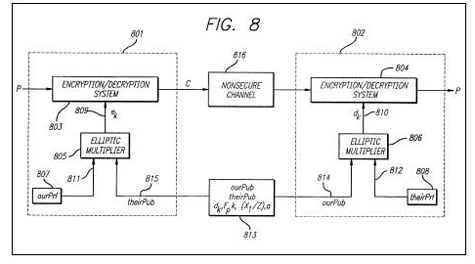Excerpts from the patent
An elliptic curve encryption scheme is described. In the following description, numerous specific details, such as number of bits, execution time, etc., are set forth in detail to provide a more thorough description of the present invention. It will be apparent, however, to one skilled in the art, that the present invention may be practiced without these specific details. In other instances, well known features have not been described in detail so as not to obscure the present invention.
A disadvantage of prior art computer-implemented elliptic curve encryption schemes is they are unsatisfactorily slow compared to other prior art computer-implemented encryption schemes. The modulo arithmetic and elliptic algebra operations required in a prior art elliptic curve cryptosystem require that divisions be performed. Divisions increase computer CPU (central processing unit) computational overhead. CPU's can perform addition and multiplication operations more quickly, and in fewer processing steps, than division operations. Therefore, prior art elliptic curve cryptosystems have not been previously practical or desirable as compared to other prior art cryptosystems, such as Diffie-Hellman and RSA schemes.
The present invention provides methods and apparatus for implementing an elliptic curve cryptosystem for public key exchange that does not require explicit division operations. The advantages of the preferred embodiment of the present invention are achieved by implementing fast classes of numbers, inversionless parameterization, and FFT multiply mod operations.
Notice
Macsimum News presents only a brief summary of patents with associated graphic(s) for journalistic news purposes as each such patent application and/or grant is revealed by the U.S. Patent & Trade Office. Readers are cautioned that the full text of any patent applications and/or grants should be read in its entirety for further details.
Note: This is a continuation-in-part of United States Patent Application 08/758,688 which is a continuation of United States Patent Application 484,264 (now issued as U. S. Patent Number 5,581,616, which is a continuation in part of United States Patent Application 08/167,408 filed December 14, 1993 which is a continuation of Unites States Patent Application 07/955,479 filed Oct. 2, 1992 (now issued as U. S. Patent 5,271,061) which is a continuation of United States Application Serial Number 07/761,276 filed Sept. 17, 1991 (now issued as U. S. Patent Number 5,159,632).
Definition of a "continuation-in-part patent: Under United States patent practice, it is possible for the owner of a pending patent application to file a what is called a "continuation-in-part" patent application. A CIP patent application is an application which contains some matter in common with a previous patent application (called the "parent" application), and that also contains new matter, and which was filed at a time when the parent application was pending. If such an application issues as a patent, then the patent has a sort of a blurred priority date. It is possible that some claims of the patent enjoy the priority date of the parent application, while other claims might enjoy only the filing date of the CIP application as their priority date.
neo@macsimumnews.com














